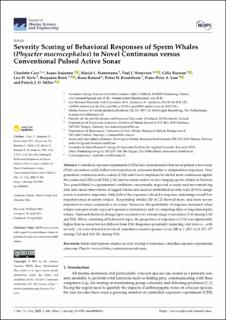Severity Scoring of Behavioral Responses of Sperm Whales (Physeter macrocephalus) to Novel Continuous versus Conven tional Pulsed Active Sonar
| dc.contributor.author | Curé, Charlotte | |
| dc.contributor.author | Isojunno, Saana | |
| dc.contributor.author | Siemensma, Marije | |
| dc.contributor.author | Wensveen, Paul | |
| dc.contributor.author | Buisson, celia | |
| dc.contributor.author | Sivle, Lise Doksæter | |
| dc.contributor.author | Benti, Benjamin | |
| dc.contributor.author | Roland, Rune | |
| dc.contributor.author | Kvadsheim, Petter Helgevold | |
| dc.contributor.author | Lam, Frans-Peter A. | |
| dc.contributor.author | Miller, Patrick James O. | |
| dc.date.accessioned | 2022-01-19T10:21:38Z | |
| dc.date.available | 2022-01-19T10:21:38Z | |
| dc.date.created | 2021-12-21T13:24:15Z | |
| dc.date.issued | 2021 | |
| dc.identifier.issn | 2077-1312 | |
| dc.identifier.uri | https://hdl.handle.net/11250/2838178 | |
| dc.description.abstract | Controlled exposure experiments (CEEs) have demonstrated that naval pulsed active sonar (PAS) can induce costly behavioral responses in cetaceans similar to antipredator responses. New generation continuous active sonars (CAS) emit lower amplitude levels but more continuous signals. We conducted CEEs with PAS, CAS and no-sonar control on free-ranging sperm whales in Norway. Two panels blind to experimental conditions concurrently inspected acoustic-and-movement-tag data and visual observations of tagged whales and used an established severity scale (0–9) to assign scores to putative responses. Only half of the exposures elicited a response, indicating overall low responsiveness in sperm whales. Responding whales (10 of 12) showed more, and more severe responses to sonar compared to no-sonar. Moreover, the probability of response increased when whales were previously exposed to presence of predatory and/or competing killer or long-finned pilot whales. Various behavioral change types occurred over a broad range of severities (1–6) during CAS and PAS. When combining all behavioral types, the proportion of responses to CAS was significantly higher than no-sonar but not different from PAS. Responses potentially impacting vital rates i.e., with severity ≥4, were initiated at received cumulative sound exposure levels (dB re 1 μPa2 s) of 137–177 during CAS and 143–181 during PAS. | |
| dc.language.iso | eng | |
| dc.title | Severity Scoring of Behavioral Responses of Sperm Whales (Physeter macrocephalus) to Novel Continuous versus Conven tional Pulsed Active Sonar | |
| dc.type | Peer reviewed | |
| dc.type | Journal article | |
| dc.description.version | publishedVersion | |
| dc.source.volume | 9 | |
| dc.source.journal | Journal of Marine Science and Engineering | |
| dc.source.issue | 444 | |
| dc.identifier.doi | 10.3390/jmse9040444 | |
| dc.identifier.cristin | 1971060 | |
| cristin.ispublished | true | |
| cristin.fulltext | original | |
| cristin.qualitycode | 1 |
Tilhørende fil(er)
Denne innførselen finnes i følgende samling(er)
-
Articles [3011]
-
Publikasjoner fra CRIStin [3061]
